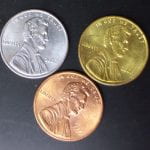DESCRIPTION:
This demo uses sodium hydroxide to plate Zn on the surface of a copper penny, making it appear silver in color. Zinc is oxidized in sodium hydroxide:
Zn(s) + OH–(aq) → ZnO22-(aq) + H2 (g)
The remaining electroplating process is not fully understood. The silvery penny can be heated to melt the zinc and copper together, creating a gold colored alloy.
TOPICS COVERED:
– chemical change
– redox
MATERIALS NEEDED:
– 250 mL beaker
– granulated Zn
– NaOH pellets
– water
– tongs/tweezers
– 3 pennies
PROCEDURE:
1. Add granulated Zn to the beaker, enough to cover the bottom of the beaker is plenty
2. Add some NaOH pellets and dissolve in water (enough to sufficiently cover the zinc)
3. Add 2 of the pennies to the beaker, and let sit until they are silver in color
4. Remove both pennies from the beaker using tongs and rinse them off
5. Using tongs, hold one of the silver colored pennies in a flame until it is gold in color
ADDITIONAL COMMENTS:
The zinc can be saved for future demos, just make sure to rinse it with water before storing. The solution can also be heated to cause a faster reaction, however caution should be taken with NaOH fumes.
SAFETY:
Caution should be taken with the sodium hydroxide solution, it is very caustic. Safety goggles should be worn at all times.
REFERENCES:
Shakhashiri, B.Z. Chemical Demonstrations; University of Wisconsin Press: Madison, 1992; Vol. 4, pp 263.
STORY:
Tell students you are an alchemist!
